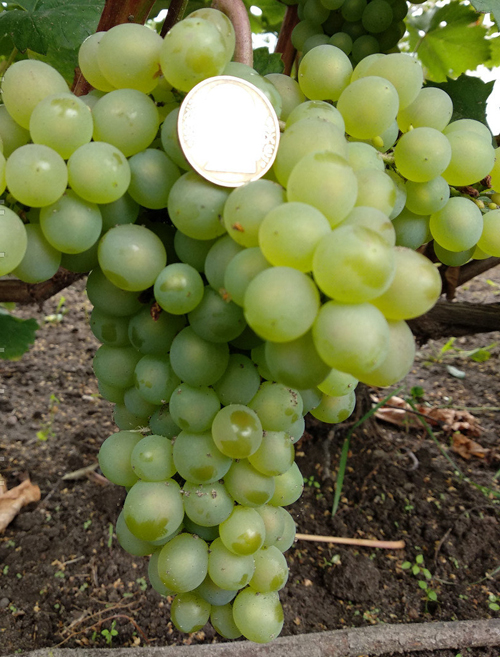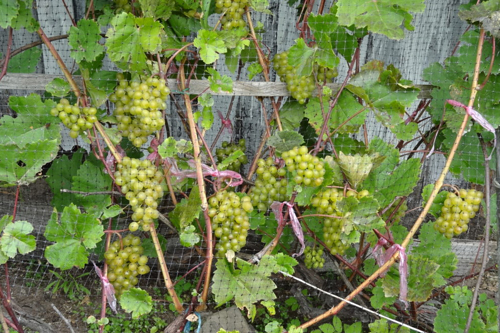Crystal grape variety
Crystal is a very successful Hungarian interspecific hybrid of white technical grapes. It is distinguished by its amazing frost resistance, resistance to fungal diseases and good quality of the wine produced from it.
Received at the Department of Genetics and Selection of the University of Horticulture (Budapest) by complex crossing of a representative of the considered cultural European-Asian species Vitis vinifera with the Amur grape Vítis amurensis, growing wild in Siberia and the Far East, and subsequent pollination of the resulting form with pollen of the famous European -American hybrid of the direct producer Villard blanc. The first experiments in the country on interspecific hybridization using Amur grapes were started by a university professor, Dr. Koleda István, back in 1955 on the basis of material brought from the Soviet Union. The main goal of the breeding program was to create winter-hardy varieties for non-sheltering viticulture in frost-prone regions. However, the study of the hybrid forms used in the work showed that they inherited from their wild Amur ancestor not only the ability to endure low winter temperatures, but also remarkable resistance to major diseases. This made them doubly valuable in the eyes of researchers. Over the course of several decades, Istvan Koleda, his colleagues and students have created a number of varieties with outstanding agricultural parameters and the highest unpretentiousness. Among them was the Kristály, born in 1974 by Kriszten György.

New grape hybrids gradually gained popularity in the country, however, for Hungary's accession to the European Union in 2004, a condition was set to terminate the program for the introduction of local complex-resistant technical varieties to please Western European winemakers, after which the many years of work of scientists were practically consigned to oblivion. Currently in Hungary they are cultivated exclusively for research purposes on several dozen acres.
The variety came to our country in the 80s of the last century, and by 2002 it successfully completed the state variety testing, after which it was admitted to industrial cultivation in the North Caucasus and Lower Volga regions. By amateurs, Crystal was distributed much to the north, where it was perfectly acclimatized, and today it pleases its owners with the excellent quality of a noble drink made from it.
Agrobiological characteristics
The growth of grape bushes is average. The crown of a young shoot is open, wine-red with a similar shade of young leaves, without pubescence. Mature leaves are medium-sized, rounded, usually five-lobed, dark green in color. The dissection of the leaf blade is different: in the former it is practically absent, in the latter it is strong. The upper lateral notches of dissected leaves are deep, closed, with an ovoid lumen, the lower ones are open, lyre-shaped with a rounded bottom, or V-shaped. The petiole notch is closed, with or without a rounded lumen. The denticles along the edge of the leaf are medium in size, transitional to dome-shaped. The surface of the leaves is reticulate-wrinkled; pubescence is absent on the underside. The flowers are bisexual, well pollinated in any weather. The Crystal is not prone to peas. The color of the young vine is red. Ripening of shoots is excellent - 90-100%. Ripe shoots change color to yellowish brown.

The bunches are rather large for a technical variety, reaching a mass of 200 grams or more. Their shape is conical or cylindrical-conical, their density is moderate. The comb is of medium length, fragile, breaks off well during harvesting. The berries are medium in size, slightly oval, white or yellow-green in good light, covered with a thin layer of whitish waxy coating. The average weight of a hundred berries is 150-210 grams.The pulp is tender, juicy, of excellent sweet taste, without specific aromas. Sugar content of berry juice at the time of technical ripeness - 17-18 grams / 100 cubic meters. cm, acidity - 6-7 grams / cubic dm. Its output is up to 80% of the crop mass. Grapes are distinguished by a sharp decrease in acidity during overripe, and a significant accumulation of glucose and fructose. The skin is thin, but strong, in percentage terms it takes up a small part in the weight of the bunch. There are 2-3 seeds in the berry, they also occupy a small part of its volume.
The harvest is intended mainly for processing into dry table wines, champagne and sherry wine materials, which are very light, refined, fresh with a harmonious fruit bouquet. The main thing is not to overexpose the bunches on the bushes, since due to the low acidity of the grapes, the drinks from it will turn out to be flat and tasteless, in addition, problems with color may arise, up to significant browning due to oxidase cash - a defect that occurs just in low acid wines. Correctly prepared still table wine from conditioned raw materials showed a tasting score of 8.5 points during the variety testing, sparkling wine - 9.5 points. In addition, thanks to not the smallest bunches and berries, as well as the decent taste of berries, many lovers enjoy fresh Crystal. It also makes good juices, but in this case it is necessary to hold the crop longer on the bush so that the juice is sweeter. The variety cannot boast of suitability for long-term storage and transportation over long distances.
The grapes ripen early. For the onset of removable ripeness, 110-115 days of growing season are enough, starting from the moment the buds bloom, and in the amount of 2200-2300 ° C of active temperatures. Thanks to this, Crystal grows well in the Moscow region, Tver and even in the Leningrad regions. In many regions of the middle zone, it does not even need shelter for the winter due to its excellent, genetically determined, frost resistance. Uncovered vines can withstand temperatures down to -29 ° C without damage, and the simplest shelters give plants the opportunity to survive a forty-degree cold.

The productivity of the Crystal is very high. Despite the low growth rate, it brings up to 200 centners of a high-quality crop per hectare. The number of fruitful shoots reaches 85-90%, and the fertility rate (the average number of clusters per fruitful shoot) is 1.3. Few classic wine grapes can match Crystal's yield. For this, stable and productive hybrids are disliked in the traditional wine-making countries of Europe, where a decent in taste and quality, but inexpensive wine can impose serious competition on local elite wineries. They justify their policy of prohibitions by concern for the health of consumers, who allegedly could be damaged by the barely noticeable increase in diglycosides in wine from hybrid forms. However, they deliberately forget to note the fact that complex-resistant varieties require much less pesticide load when growing than traditional ones, and therefore are more environmentally friendly.
Agrotechnical features
With the cultivation of the Crystal, which has unique characteristics in terms of unpretentiousness, winegrowers, even beginners, should not have any problems at all.
Landing should be carried out in accordance with the usual requirements. The variety does not have a special predisposition to soils, the only exception is excessively dry or, conversely, damp, wetlands, cold lowlands, northern slopes, on which the culture, in principle, cannot grow normally. There are no data on resistance to phylloxera, therefore, in the zone of its infestation, grape propagation by grafted seedlings is required.
High frost resistance makes it possible to form bushes on a high stem in many regions, including those outside the traditional vine-growing areas. However, where winter temperatures drop below the thirty-degree mark, even our hero will not do without shelter.Here it is advisable to choose the shape of the bush taking into account the convenience of removing the vine from the trellis, and then laying it on the ground for insulation, or even burying it in the ground. A multi-arm fan formation or an inclined cordon, widespread among winegrowers of the covering zone, is quite suitable for this. The easiest shelter is quite suitable, unless, of course, your vineyard is located in harsh Siberia. In extreme winter temperatures, the Crystal still needs serious insulation.
The load on fruit-bearing grape bushes can be very significant, the variety very rarely shows signs of overload. In spring pruning, up to 60 eyes are left on the plants. At the same time, the high productivity of the lower buds allows for short pruning, leaving 2-3 eyes per fruit arrow. After the start of the growth of shoots, a fragment of part of them is carried out, removing the sterile, weak and growing in two or three from one bud. To prevent thickening of the bushes, pinching is carried out in the vineyard during the summer. But to thin out the bunches, as is done on table varieties, is not at all necessary here - the Crystal will "pull" them all.
The resistance of the form to the main fungal diseases is expressed by the following indicators: to mildew - 2 points, to oidium - 2.5 points, it is immune to gray rot. This makes it possible to obtain an ecologically clean crop almost everywhere, by abandoning the use of chemical plant protection products. For this variety, preventive measures of an agrotechnical nature will be sufficient, first of all, ensuring good ventilation of the crown. Only in warm and humid climates with ideal conditions for the development of fungal pathogens, single fungicide treatments of grapes may be required. The only ones that need to be seriously fought against are wasps, showing an increased interest in sweet berries with a thin skin. Special traps or containers with sugar syrup, where stubborn insects fall and drown, will help to solve the problem.
For all its simplicity, the Crystal responds well to watering and fertilizing with mineral fertilizers. Providing sufficient soil moisture is especially noticeable in arid regions, where lack of water is the main limiting factor for obtaining the highest possible yields.
In general, it is necessary to recognize this variety as one of the best versatile grape varieties that can successfully grow in the hot south and the harsh north, both there and there showing excellent results in terms of productivity and fruit quality. By the totality of its characteristics, without exaggeration, it can be called the pride of the Hungarian selection, and it is a pity that in its homeland it was never appreciated due to political and economic nuances. Fortunately, thanks to the growing popularity in the post-Soviet space, Kristall found, in fact, a second home, and escaped possible oblivion.








